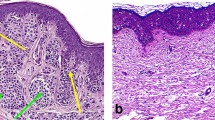Abstract
Total excision of congenital melanocytic nevi (CMN) is not always feasible. We here present our experience of using carbon dioxide laser and Q-switched neodymium-doped yttrium-aluminum-garnet (Nd:YAG) laser to treat nodular CMN of the nasal ala. Q-switched Nd:YAG laser and/or carbon dioxide laser were used to treat eight cases of nasal ala nodular CMN. Carbon dioxide laser was utilized to ablate all visible melanocytic tissue within one session. Ablation was performed so as to reproduce the original anatomical contours as closely as possible. Recurrences were treated in the same way. Q-switched Nd:YAG laser was also used to irradiate all target lesions to achieve the desired end point within one session. The intervals between treatments were at least 8 weeks. Recurrence of melanocytic tissue, scar formation, pigmentation, depigmentation, and the degree of patient satisfaction were recorded at every visit. Two of the eight patients were treated with Q-switched Nd:YAG laser. Although, the lesion lightened in one of them, the hyperplastic tissue persisted. Eventually, these two patients, along with the remaining six patients, were successfully treated with a carbon dioxide laser. We recommend carbon dioxide laser treatment for nodular nasal CMN. This simple treatment does not involve skin flap transplantation and has good cosmetic outcomes. Although Q-switched Nd:YAG laser does lighten some nasal nodular CMNs, it does not eradicate the hyperplastic tissue, and is therefore not an effective treatment for nodular nasal CMN.



Similar content being viewed by others
References
Zayour M, Lazova R (2011) Congenital melanocytic nevi. Clin Lab Med 31:267–280
Margulis A, Adler N, Bauer BS (2009) Congenital melanocytic nevi of the eyelids and periorbital region. Plast Reconstr Surg 124:1273–1283
August PJ, Ferguson JE, Madan V (2011) A study of the efficacy of carbon dioxide and pigment-specific lasers in the treatment of medium-sized congenital melanocytic naevi. Br J Dermatol 164:1037–1042
Silistreli OK, Demirdover C, Ayhan M et al (2005) Prefabricated nasolabial flap for reconstruction of full-thickness distal nasal defects. Dermatol Surg 31:546–552
Tan E, Mortimer N, Salmon P (2014) Full-thickness skin grafts for surgical defects of the nasal ala—a comprehensive review, approach and outcomes of 186 cases over 9 years. Br J Dermatol 170:1106–1113
Byrd DR, Otley CC, Nguyen TH (2000) Alar batten cartilage grafting in nasal reconstruction: functional and cosmetic results. J Am Acad Dermatol 43:833–836
Yotsuyanagi T, Yamashita K, Urushidate S et al (2000) Nasal reconstruction based on aesthetic subunits in Orientals. Plast Reconstr Surg 106:36–44
Liu J, Ma YP, Ma XG et al (2011) A retrospective study of q-switched alexandrite laser in treating nevus of ota. Dermatol Surg 37:1480–1485
Choudhary S, Elsaie ML, Leiva A et al (2010) Lasers for tattoo removal: a review. Lasers Med Sci 25:619–627
Ho SG, Goh CL (2015) Laser tattoo removal: a clinical update. J Cutan Aesthet Surg 8:9–15
Grevelink JM, van Leeuwen RL, Anderson RR et al (1997) Clinical and histological responses of congenital melanocytic nevi after single treatment with Q-switched lasers. Arch Dermatol 133:349–353
Kishi K, Okabe K, Ninomiya R et al (2009) Early serial Q-switched ruby laser therapy for medium-sized to giant congenital melanocytic naevi. Br J Dermatol 161:345–352
Nelson JS, Kelly KM (1999) Q-switched ruby laser treatment of a congenital melanocytic nevus. Dermatol Surg 25:274–276
Schmoeckel C (1997) Classification of melanocytic nevi: do nodular and flat nevi develop differently? Am J Dermatopathol 19:31–34
Gloster HM Jr, Roenigk RK (1995) Carbon dioxide laser for the treatment of cutaneous lesions. Clin Dermatol 13:25–33
Fairhurst MV, Roenigk RK, Brodland DG (1992) Carbon dioxide laser surgery for skin disease. Mayo Clin Proc 67:49–58
Author information
Authors and Affiliations
Corresponding author
Ethics declarations
Funding
None.
Conflict of interest
None declared.
Rights and permissions
About this article
Cite this article
Zeng, Y., Ji, C., Zhan, K. et al. Treatment of nasal ala nodular congenital melanocytic naevus with carbon dioxide laser and Q-switched Nd:YAG laser. Lasers Med Sci 31, 1627–1632 (2016). https://doi.org/10.1007/s10103-016-2028-2
Received:
Accepted:
Published:
Issue Date:
DOI: https://doi.org/10.1007/s10103-016-2028-2




